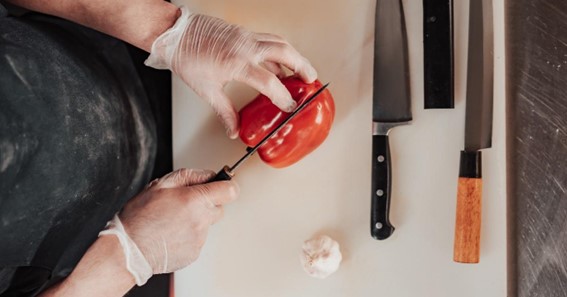Cooking is much easier and fun when you have all the right tools at your disposal. Knives are the basic yet most important tool that a home chef needs in their kitchen.
However, with so many different types of knives available, many wonder which knife serves what purpose. Rightfully so, it can be confusing at times to understand what each knife can do and is it really necessary to have so many of them?
To understand which knife is used for what purpose, you can use the following guide.
So, grab a knife and a cutting board and get ready to cook some great meals.
Types of Knives
Kitchen knives are made from 440c steel, which is a common material in the production of cutting tools. Kitchen knives can either be multipurpose or single purpose. A multipurpose knife is suitable for a variety of tasks, while a single-purpose knife is specially designed for a special cutting task.
You can learn more about these two knife types below:
Multipurpose Knives:
These knives serve many a purpose in the kitchen.
Chef’s Knife
A chef’s knife or a cook’s knife is one of the most important and versatile cutting tools that you can own if you do any kind of cooking. Many professional chefs will tell you that if you can have only one knife in your kitchen, it should be the chef’s knife.
It can be used for a variety of purposes including chopping, cutting, slicing, and mincing. These are ideal for cutting and chopping vegetables, fruits, fish, poultry, and meat.
It has a broad blade that curves upward into a pointy tip. This shape allows it to rock back and forth easily on a chopping board. Chef’s knives are usually 6 to 12 inches long.
You can choose the size that best fits your hands. Or in case, you need more information, you can read more to find your chef knife size.
Click here – Work and Travel Is Not Just For US Now With Remote Working
Santoku Knives
Santoku knives are also smaller in size with a slightly tapered blade to allow for more intricate incisions.
This knife is similar to the chef’s knife but is smaller in size. The knife is ideally used to slice up fish. Along with fish, you can cut vegetables and fruits with it as well. Many people love to use these knives for preparing sushi or for cutting raw fish.
It has dimples on the blade which make it easier for the food to slide off.
Utility Knife
A kitchen utility knife is ideal for tasks that are too big for the chef’s knife to handle. You can use it to cut or slice small vegetables and fruits such as lemons, cucumbers, and zucchini.
These are usually 4 to 7 inches long and can come either with a serrated or straight blade. A serrated utility knife can also be used for slicing bread. You may also use a straight utility knife for peeling fruits and vegetables, although it might not be the best tool for the task.
Paring Knife
A paring knife has a very small size but a blade that is super sharp. These are light in size and allow for better handling when working on delicate tasks, like garnishing.
These are great for peeling, slicing, chopping, mincing and removing seeds from vegetables and fruits. Though not great for cutting large food items or meat, a paring knife usually works best for anything that requires incisive and precise cutting.
You can cut hard vegetables, such as potatoes, or peel fruits with a paring knife. However, you have to keep the blade of the knife sharp if you want it to keep cutting into hard vegetables.
You can use wooden cutting boards to keep the blade sharp for a longer time.
Bread Knife
If you have trouble working on softer foods, such as a bread or tomatoes, you should give the bread knife a try.
A bread knife has a long-serrated blade, just like a saw. A bread knife is great for cutting all types of bread, including the baguettes, crusty bread, bread rolls, and bagels.
These can also be used to cut cakes, tomatoes, chocolate bars, large melons etc., anything that squishes and slips under any other ordinary knife.
The blade of a bread knife ranges from 7 to 10 inches long and it is always serrated. The serrated blade allows it to cut through soft food items without applying much pressure.
Single Purpose Knives
These knives serve a singular purpose in the kitchen.
Cleaver
A meat cleaver is often called the butcher’s knife. It has a large rectangular-shaped blade and is the heaviest of them all.
Although many people use it for various other purposes, such as chopping vegetables and crushing garlic, these are specially designed to chop meat.
Its large size and heavy weight allows it to easily cut through bone. However, this type of knife is only used for raw meat and not for cooked food.
Boning Knife
If you work with meat most of the time, a boning knife is a must-have. Boning knife is specially designed to separate bone from the meat. It is also used for cutting meat and filleting fish.
Usually small in size (around 6 inches), boning knives have a very sharp blade to cut around bones where other knives struggle.
A boning knife is available either as a rigidly constructed blade or a flexible blade. The rigid blade is best suited for separating meat clean off the bones, while the flexible blade can be used to cut meat.
Filleting Knife
Similar to the boning knife in both purpose and shape, filleting knives are thinner and flexible. These have a very sharp blade and are great for filleting fish. The sharp blade allows it to separate the bones without ruining the fish meat.
Nakiri Knife
Nakiri knives are specially designed to cut vegetables. These are similar to meat cleavers in shape but with a smaller and thinner blade.
The large size of the rectangular-shaped blade allows it to cut through vegetables easily without needing to rock it backwards and forwards, like you would when using a chef’s knife to chop the vegetables.
It also makes it ideal for shredding large vegetables such as lettuces and cabbages.
Tourne Knife
A tourne knife has a small blade that is curved like a bird’s beak. It is specially designed to peel vegetables and fruits. These usually have a very sharp blade and an ergonomic handle to make it easier to peel.
A peeling knife has a small blade, generally ranging from 3 to 4 inch. It is ideal for peeling fruits and vegetables, such as potatoes, apples, etc.
Conclusion
Kitchen knives are amongst the most important tools for a chef to have. From cutting meat to chopping vegetables, there is a knife for every purpose. Some knives are designed to perform multiple tasks and some are designed for special purposes.
To make your work easier, it is essential to understand which knife is suitable for what purpose. This guide can help you better understand when to use what knife. It gives information on both the general and special-purpose knives.
Click here – What Is Medigap Insurance? And Who Needs It?





